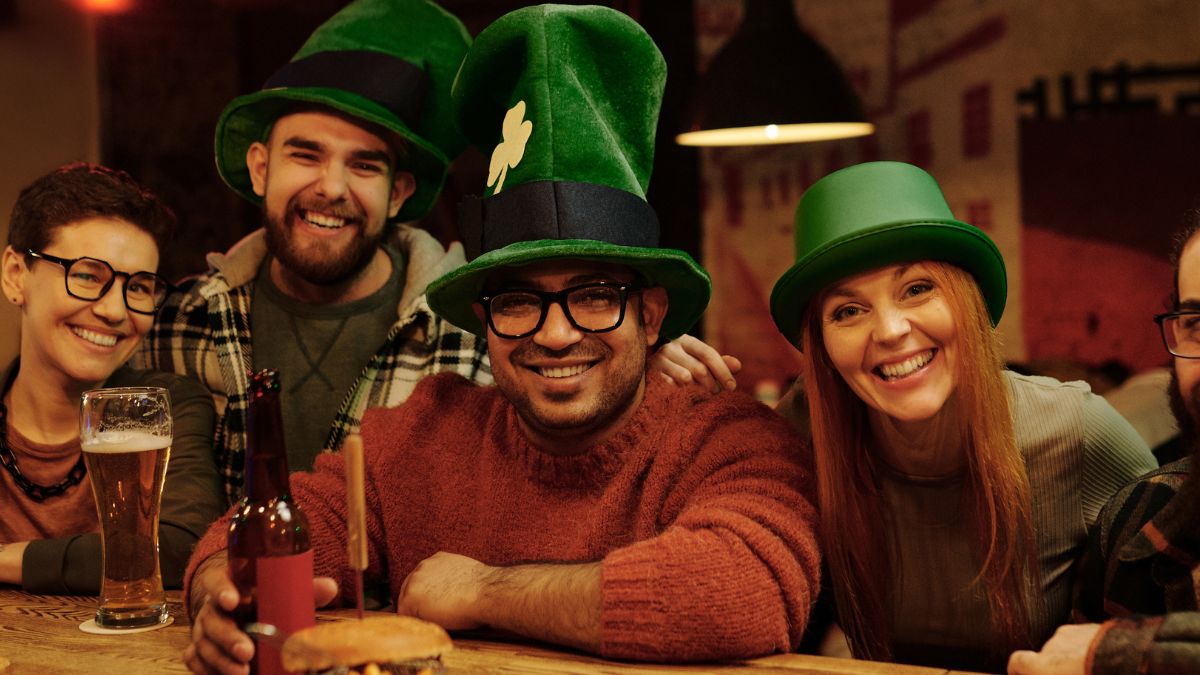St. Patrick’s Day is known for its vibrant green colors, festive parades, and joyful celebrations. However, there is an alternative color that some people choose to wear on this day – orange. Wearing orange on St. Patrick’s Day has its roots in Ireland’s history and represents a different facet of the Irish heritage.
The choice to wear orange on St. Patrick’s Day stems from the longstanding division between Ireland’s Catholic and Protestant communities. The color orange symbolizes the Protestant community and their heritage, while green represents the Catholic community.
This distinction has led to some choosing to wear orange as a way to express their cultural identity and religious beliefs.
Key Takeaways
- Due to its historical and religious significance, Orange is an alternative color worn on St. Patrick’s Day.
- The choice to wear orange represents the Protestant community in Ireland, while green is associated with the Catholic community.
- Incorporating orange and green into St. Patrick’s Day outfits can be a creative way to celebrate and acknowledge Ireland’s diverse heritage.
History of Wearing Orange on St Patrick’s Day
Wearing orange on St. Patrick’s Day has its roots in Irish history, specifically, the events surrounding the Battle of the Boyne in 1690. During this conflict, William of Orange, the King of England, Scotland, and Ireland, defeated the Roman Catholic King James II. This victory solidified Protestant control over Ireland, and as a result, the Irish Protestant community became closely associated with the color orange.
While the celebration of St. Patrick’s Day originates in the Roman Catholic tradition and was first celebrated in Ireland around 1631, the holiday has evolved to embrace the entire Irish community.
As St. Patrick’s Day festivities gained popularity in America, the holiday’s colors shifted from St. Patrick’s signature shade of blue to the now-iconic green. This change helped to symbolize the broader cultural celebration it has become today.
Therefore, wearing orange on St. Patrick’s Day holds significance for the Protestant Irish community, serving as a symbol of their heritage and the historical event of William of Orange’s victory.
While many people wear green to represent their Irish ancestry and the lush landscapes of Ireland, some choose to wear orange as a nod to their specific religious affiliation and historical connections.
In today’s St. Patrick’s Day celebrations, both the colors green and orange can be seen, representing the diverse origins and backgrounds of the Irish people. By displaying these colors, individuals come together to celebrate Irish history, culture, and the unifying spirit of the holiday itself.
The Symbolism of Orange in Irish Tradition
The color orange holds a significant place in Irish history and tradition. It is often associated with the Protestant community, while the color green symbolizes the Catholic community in the country.
The origin of this symbolism dates back to the reign of William of Orange, a Protestant king who overthrew Roman Catholic rule in Ireland during the late 17th century.
A key event in Irish history that represents the importance of the color orange is the Battle of the Boyne in 1690.
In this battle, William of Orange, a Protestant, led his troops to victory against the deposed Catholic king James II, solidifying Protestant rule in Ireland. This event led to the association of the color orange with the Protestant community.
The distinction between the two colors can also be observed in the Irish flag, which consists of green, white, and orange vertical stripes.
The green stripe represents Roman Catholicism, while the orange stripe symbolizes Protestantism. The white color in the middle signifies a peaceful union between these two religious communities.
On St. Patrick’s Day, a traditional Irish holiday celebrating St. Patrick, the patron saint of Ireland, some people wear orange instead of the typical green attire. This decision is often based on the individual’s religious or political beliefs and their connection to the Protestant community.
However, it should be noted that wearing orange on this day is not a widespread practice, and the majority of Irish people around the world still don the color green to celebrate St. Patrick’s Day.
In conclusion, orange is an important symbol in Irish tradition, mainly representing the Protestant community and their heritage. Although not commonly worn on St. Patrick’s Day, it remains a significant aspect of Irish culture and history.
Controversial Aspects of Wearing Orange
One reason behind the controversy of wearing orange on St. Patrick’s Day is its historical significance. While Catholics are associated with the color green, Protestants are linked to the color orange due to William of Orange, the Protestant king of England, Scotland, and Ireland.
Given that St. Patrick’s Day is a Roman Catholic holiday celebrating the patron saint of Ireland, some people argue that wearing orange can be seen as a political statement or expression of Protestant identity rather than in the spirit of the holiday.
In this context, the choice of color may sometimes lead to tension or misunderstandings between individuals.
However, it should be noted that the Irish flag features green and orange alongside one another, separated by a white stripe, as a symbol of unity between the two religious communities in Ireland.
As such, wearing orange on St. Patrick’s Day may also be a way to acknowledge and respect the Protestant community’s contribution to Irish history and culture.
Ultimately, it is essential for all participants to understand the historical context and potential interpretations of the tradition.
As with many customs, wearing orange on St. Patrick’s Day can be an opportunity to engage in dialogue and promote understanding between different cultural and religious groups. By doing so, the celebration can become a unifying experience for everyone to enjoy together.
Global Trends: Wearing Orange on St Patrick’s Day
St Patrick’s Day is often associated with the color green, but in recent years, many people have opted to wear orange instead. Wearing orange on St Patrick’s Day is linked to the history of religious affiliations in Ireland. The color orange symbolizes the Protestant community, while the color green represents the Catholic community.
In many countries with Irish communities or cultural connections, this trend of wearing orange has gained popularity as a nod to the historical and cultural significance of the color.
In the United States, for example, some people wear orange to pay homage to their Protestant Irish heritage, while others may choose to wear it as a way to promote religious unity and understanding.
Wearing orange on St Patrick’s Day is not only limited to the Irish diaspora but also embraced by people from varied backgrounds.
Individuals sometimes opt for orange as a personal preference or to stand out from the sea of green commonly seen during St Patrick’s Day celebrations. In other instances, people wear the color to make a statement about religious or cultural diversity.
In conclusion, the rising trend of wearing orange on St Patrick’s Day reflects a desire to acknowledge the complex history of Ireland and promote understanding between different communities.
With each passing year, it seems that more and more people are opting to don the vibrant hue, making orange an increasingly visible part of St Patrick’s Day celebrations worldwide.
How to Incorporate Orange in Your St. Patrick’s Outfit
For Men
Men have several options when it comes to incorporating orange in your St. Patrick’s Day outfit. One popular choice is to wear an orange tie with a neutral shirt and suit.
Alternatively, you can opt for an orange button-down shirt or polo shirt to make a bolder statement. If you prefer a subtler approach, consider accessorizing with an orange pocket square or pair of socks.
For Women
Women looking to incorporate orange into their St. Patrick’s Day attire have many fashionable choices. Start with a stylish orange blouse or dress to make a statement. For a more subtle touch, try wearing a bright orange scarf or a piece of orange jewelry, such as a necklace, bracelet, or earrings.
Consider adding a pair of orange shoes or a chic handbag to complete your festive look.
For Children
Incorporating orange into children’s outfits for St. Patrick’s Day can be fun and easily achieved. Opt for a cute orange shirt or dress, and pair it with green leggings or pants for a festive and coordinated look.
Accessorize with orange hats or headbands to complete the outfit. Some children might even enjoy wearing fun orange themed accessories such as temporary tattoos or face paint to really get into the spirit of the day.
St Patrick’s Day Fashion Tips: Balancing Orange and Green
When it comes to St. Patrick’s Day fashion, green is typically the go-to color. However, the fun doesn’t have to stop there – why not add some orange into the mix?
This guide will provide tips on how to balance both orange and green for a fresh and festive look.
First, try mixing different shades of green and orange. This adds visual interest and makes your outfit appear less monochromatic.
For instance, combine a bright emerald green with a burnt orange or a soft shades of both colors. This contrast allows each color to stand out independently, while still maintaining the connection to St. Patrick’s Day.
Pairing your colors with neutral shades is another effective way to balance your outfit. For instance, you can try a green blouse with a pair of dark denim jeans and an orange statement necklace.
Alternatively, wear a orange dress with a green jacket and accessorize with neutral shoes and bag. Using this method, you can create a stylish outfit that still includes festive tones without overpowering.
Accessories are essential when incorporating orange and green into your St. Patrick’s Day ensemble. If you’re worried about wearing too much color, you can opt for small, subtle touches of orange and green.
Consider wearing a simple outfit, like an all-black ensemble, and then add a green scarf or an orange bracelet. Life is in the details, after all.
Lastly, you can experiment with various patterns and textures to add depth and uniqueness to your St. Patrick’s Day attire. For instance, mixing fabrics like lace, satin, or velvet can bring your outfit to life.
In addition, opting for clothing items with patterns like stripes, polka dots, or floral prints can evoke a playful vibe.
Remember, the goal is to strike a harmonious balance between orange and green elements and not wear both head-to-toe colors. By following these tips, you’ll be able to create a fashionable and festive outfit that stands out from the sea of green typically seen on St. Patrick’s Day.
Conclusion
Wearing orange on St. Patrick’s Day is a tradition that holds significance for some individuals, particularly those with Protestant Irish heritage.
The choice of orange as an alternative color is deeply rooted in history, dating back to the time of William of Orange, who was instrumental in the Protestant Reformation in Ireland. This tradition serves as a reminder of the Irish community’s complex social and religious dynamics.
A comprehensive acknowledgment of Ireland’s diverse identity is achieved by embracing both green and orange hues during St. Patrick’s Day celebrations.
The choice to wear orange also highlights the importance of inclusivity and the ability to celebrate one’s heritage without infringing on the traditions of others.
Ultimately, whether individuals opt to wear green, orange, or a combination of both colors, the spirit of St. Patrick’s Day is about coming together to honor the rich cultural influences that have shaped Irish history and identity.
By respecting each other’s choices and traditions, we can truly embody the spirit of unity and goodwill that St. Patrick’s Day represents.

Cardi “likes to party” Clark has 15+ years of designing, planning, and executing successful parties and events. Highly skilled in event strategy, management, planning, and execution with a track record of exceeding expectations. I make it happen. I get it done and people have fun!









